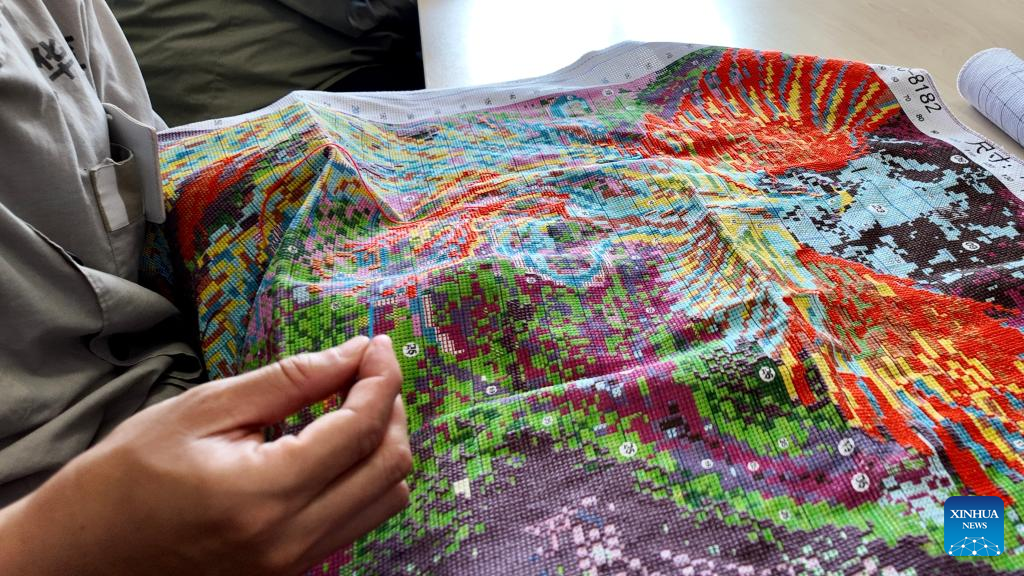
An inmate stitches embroidery at Kenhua Prison, about 150 km from downtown Beijing, capital of China, June 12, 2025. (Xinhua)
by Xinhua writers Shi Yifei, Li Yan and Xiong Lin
BEIJING, June 27 (Xinhua) -- Prison guard Zheng Tianxiao now begins his shift carrying a set of needles and threads for embroidery, a mind-soothing training employed by Kenhua Prison, about 150 km from downtown Beijing.
This prison houses male inmates serving heavy sentences for violent crimes, drug trafficking and fraud. Many of these prisoners tend to lose their sense of purpose upon arrival.
"They often resist efforts at rehabilitation," Zheng told Xinhua. "Embroidery offers a means for them to restore discipline and hone concentration."
Across China, many prisons have introduced traditional embroidery into their rehabilitation programs in recent years to encourage reflection and self-improvement, one stitch at a time.
The Beijing prison took the concept a step further by combining embroidery with mindfulness training, in an effort to amplify the rehabilitative benefits of both practices.
"Violence often stems from emotional dysregulation," said Cao Guangjian, a senior correctional psychologist at the Beijing Bureau of Prison Administration. "Mindfulness helps inmates break free from negative thoughts and teaches them to create space between stimulus and response."
For more than a decade, mindfulness has been a key part of Beijing's prison education and rehabilitation programs. Over 30,000 prisoners have taken part in such training, demonstrating improved emotional management and significant reductions in aggressive behavior, according to official data.
Zheng, who also serves as mindfulness instructor, was inspired by a visit to an embroidery exhibition earlier this year -- he found a unique connection between the meticulous rhythm of stitching and the principles of mindfulness.
"Both require complete concentration on the present moment," Zheng explained.
After studying various traditional Chinese embroidery styles, Zheng chose tiaohua, a national-level intangible cultural heritage, known for its relatively simple yet intricate technique.
Zheng and his colleagues then spent weeks searching for ways to eliminate injury risks. They opted for child-safe plastic needles, which are soft and flexible. "These needles flex upon contact with skin," Zheng said. "There's no risk of causing injury."
The embroidery session functions as an interest group supplementing regular labor and education schedules. It has recorded 84 times of participation among the over 100 offenders under Zheng's supervision.
Qing (pseudonym), one of the first to join the program, is currently serving a 16-year sentence for organized crime. At first, he was skeptical and impatient.
"Mistakes made me furious," he said with an embarrassed half-laugh as he recalled his early resistance. "I would rather haul bricks than hold a needle."
With patient guidance by Zheng and his colleagues, Qing finished his first piece in just a week -- a vibrantly colored parrot keychain. "For the first time, I was filled with the sense of accomplishment."
Once notorious for his explosive temper, Qing used to lash out at guards and fellow inmates. "Back then, I handled everything with my fists. Now, I take a deep breath and try to stay in control," he said.
In the same cell block, Fang (pseudonym), serving life imprisonment, was the first inmate to finish a full embroidery project -- a white rabbit cradling a large bouquet of sunflowers.
In May, he presented this work to his mother as his very first Mother's Day gift.
Not long after, Fang took on an even greater challenge, embroidering a phoenix rising from the ashes. This task would require 170,000 stitches over eight months. "True rehabilitation is rising from the fire like the phoenix," Fang said.
During the initial stages, inmates followed pre-designed patterns provided by the prison. Now, they're encouraged to create original works, Zheng added.
Deputy Warden Chao Kai sees this approach as a break from traditional reform methods. "Compared to conventional education, 'mindfulness + cultural heritage' programs encourage active participation from both the prisoners and the guards."
Expanding beyond embroidery, Kenhua now integrates clay sculpture, tie-dye, dragon dance, and grain painting with mindfulness training.
Notably, psychological assessments confirmed a significant reduction in anxiety and depression among inmates participating in the mindfulness-based activities, Chao added.
Advances in psychological research in China have bolstered evidence-based approaches to offender rehabilitation, said Liu Xinghua, a professor of psychology at Peking University and a long-time advisor to mindfulness programs within Beijing's correctional system.
"Prisons are enhancing rehabilitation protocols through both scientific and humanistic approaches, with increased focus on post-release social reintegration," Liu said.
Next month, Kenhua plans to invite certified intangible cultural heritage practitioners to deliver advanced training, thereby equipping inmates with marketable skills that they can use after their release.
"Our vision is to transform inmates' sentences into 'semesters,'" said Le Chengzhang, the public affairs head of the Beijing Bureau of Prison Administration. "Through corrective education, we encourage remorse and empower individuals to become contributing members of society."
When asked what he would tell his younger self, before the mistakes and the detours from a constructive path, Qing leaned back briefly, lowered his head, and blinked rapidly as he gathered his thoughts.
After a weighted silence, he said, "Life is so short. Try to be someone who does some good in the world." ■



